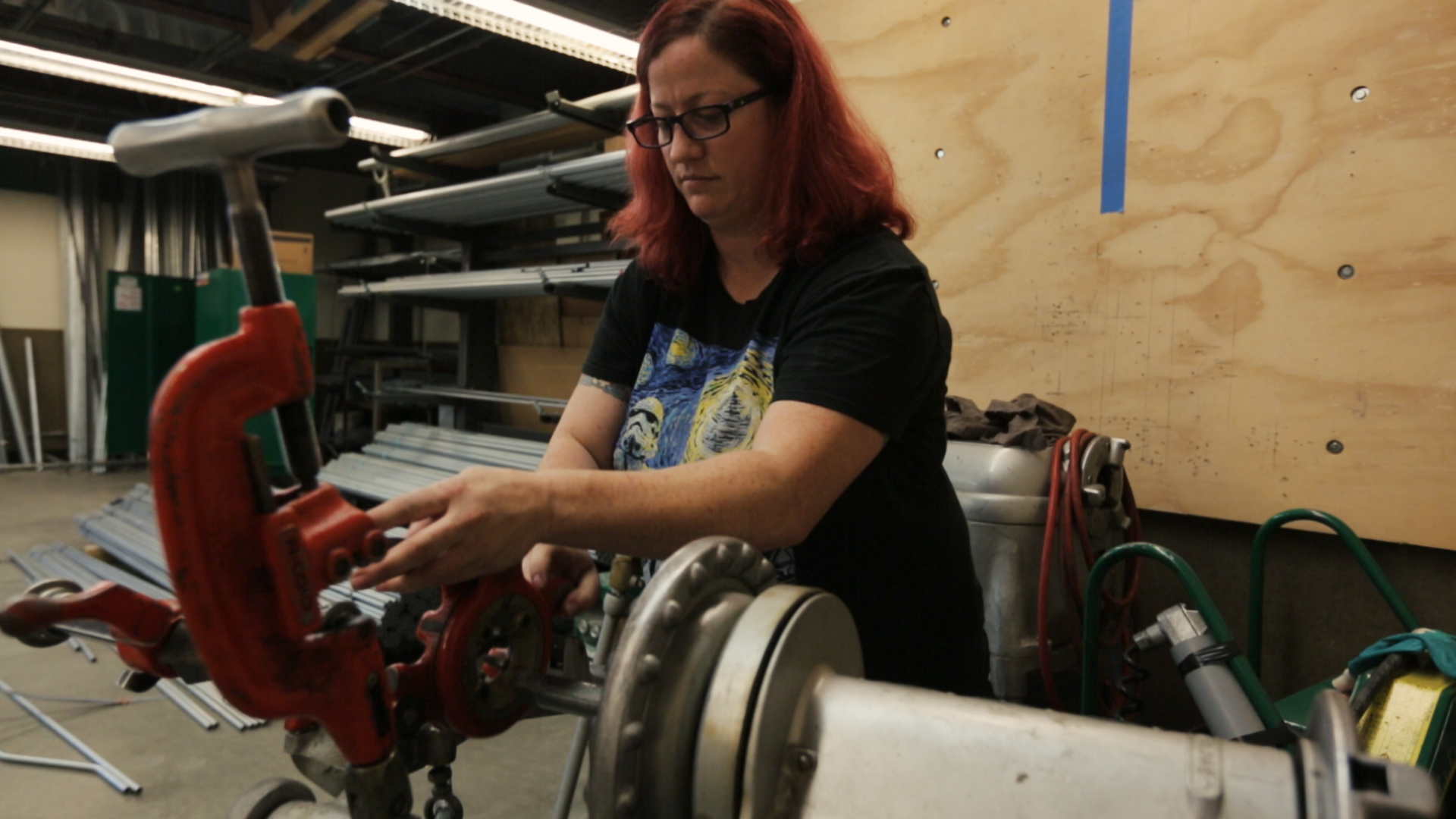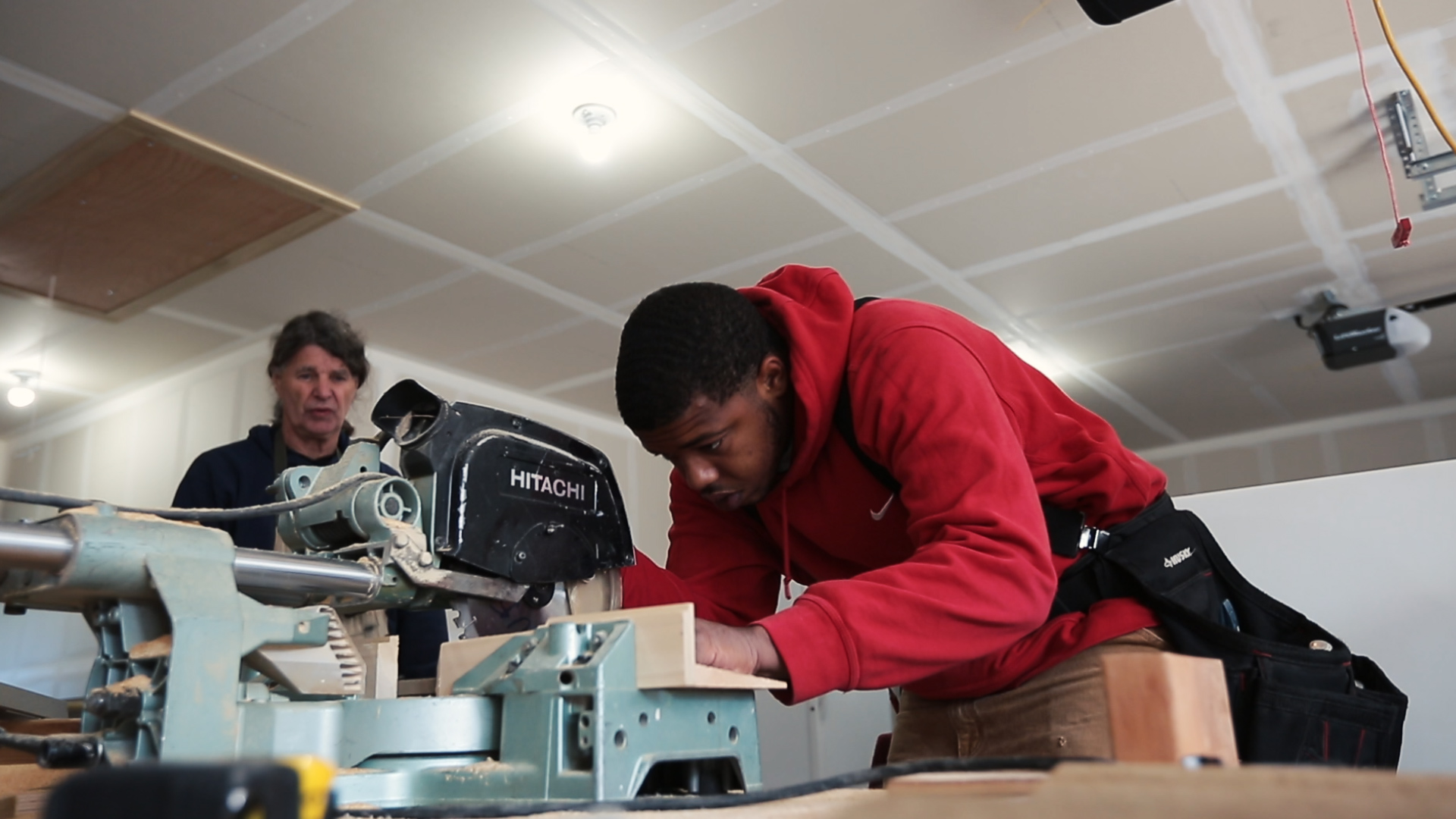
Photos By Paul Joseph Brown
Sharon Stukalo is in the fifth year of an electrician’s apprenticeship program.
(Part 2 of 2)
Da’Sean Harrison, 22, has ambitions to be a general contractor, a master of all trades. Now working on a construction job in the Seattle area, he marvels over the skills of one worker he and his co-workers have nicknamed “wizard.”
Harrison wants to be a wizard. The Washington state legislation that provides funding for apprenticeships for youth in foster care could help turn him, and other foster youth, into wizards on the job site.
“You would be hard to fire because you know so much,” he said with a slight chuckle. “My goal is to learn a lot about everything.”
Harrison is part of the Graduation Success program at Treehouse, a 30-year-old nonprofit in Seattle that serves youth in foster care.
One obstacle to his goal is the cost of tools. He worked on a job for the YMCA in Seattle where the tools he needed to complete the task sell for $1,500, he said. That’s an expense typically out of reach for youth who have been in foster care, like him. The new legislation can help pay for those tools for youth in care who are in an approved apprenticeship program. Harrison was eventually provided the tools for this particular job by the lead contractor, but he won’t always be that fortunate.
When he was younger, Harrison worked with his uncles on building projects and took pride in the finished work. The Passport to Apprenticeship Opportunities program, part of Passport to Careers, can help him create his own success story. “I like recalling those memories,” he said.
It can also help him avoid the burden his college-educated brother is facing. “One of my brothers is about to be done with college and after college he is going to be in debt damn near $150,000,” he said. “That’s not living life; that’s more stress.”
The Association for Career and Technical Education (ACTE) says more young adults, like Harrison, are being drawn into the trades and there’s a “national enthusiasm” around apprenticeships. In 2017, 49 states and the District of Columbia passed policies addressing career readiness and workforce development. Since 2013, the number of states that adopted policies related to technical education has risen from 31 to 49.
Harrison knew as a teenager he was not going to go to college and had to find a career. It is a familiar struggle for all youth, not just youth in foster care.
Exposure needed
A priority for youth in foster care is making sure high school career counselors are successfully assessing the youth’s strengths, said Angelique Day, a national expert on youth in foster care and an assistant professor of social work at the University of Washington.
“They need to take tests to understand what their strengths are, what kinds of careers are right for them and focus on some things that address personalities,” Day said. “Those guidance assessment tools will ask ‘Do you prefer to work with your hands?’
“Those assessments are designed to be sensitive enough to pick up on trade jobs versus higher-ed jobs.”
Day designed a program while at Michigan State University called F.A.M.E., or Fostering Academics, Mentoring Excellence. It’s a three-day residential summer camp program for youth in foster care transitioning out of the child welfare system. F.A.M.E. was designed to help foster youth transition from high school to college by exposing them to such things as living in a dorm, attending a class and completing an assignment.
The same intervention can be applied to youth who might want to go to trade school or do an apprenticeship, Day said. They need exposure in high school to careers in the trades the same way students going to college need exposure to campus life.
Free training under PACT
There is building momentum nationally for students — foster care and others — to get exposure to the trades through apprenticeships. It is as if a 911 call has gone out for governments, from federal on down, and construction groups to recruit the next generation of tradespeople.
There is a precedent for public dollars being spent on the trades, Day said. Project CRAFT (Community Restitution and Apprenticeship-Focused Training), which started in 1994, helped address the home building industry’s need for entry-level workers. The U.S. Department of Labor’s Employment and Training Administration awarded a Youth Offender demonstration grant to Home Builders Institute (HBI) to train adjudicated youth.
Project CRAFT has evolved into HBI’s Pre-Apprenticeship Certificate Training (PACT), which not only works with at-risk youth, but with transitioning military members, veterans, secondary and post-secondary students, unemployed and displaced workers, and justice-involved youth and adults.
The students who participate in PACT do not pay for the training in its 10 disciplines, which include carpentry, masonry, electrical, etc. HBI, which is a nonprofit, receives funding from sources in the housing industry and from various funders that pay for the curriculum. HBI also has contracts with government agencies, such as Job Corps and the Florida Department of Justice.
PACT training is happening in 45 states. What’s more, the curriculum is licensed out by HBI across the country to municipalities and private contractors, said Lynne Harris, vice president for corporate communications for HBI.
Because Houston now has a construction worker shortage as it recovers from 2017’s Hurricane Harvey, HBI partnered with Norbord, a construction materials manufacturer, to create the HBI Acres Homes Training Program there. It’s a free, 12-week course for 14 students to learn skills in the construction industry.
California, New Jersey have programs
In California, the state has invested $15 million in the last three years in the California Apprenticeship Initiative to create new apprenticeship programs in various industries. The initiative pays for preapprenticeship programs.
There are nearly 82,000 active apprentices in California, said state Labor and Workforce Development Agency Secretary David M. Lanier in a press release.
“California has many private and public funded employment readiness programs for foster youth,” said Camille Bailey of the National Center for Youth Law via email. “They are usually county specific and range from short term general employment training, paid internships, and long term employment placements.”
New Jersey is spending $10 million on its Apprenticeship Network beginning in 2019. A carpentry training center, with a focus on skilled construction workers, will open.
Lowe’s, the home store, has a Track to the Trades initiative, which is a preapprenticeship program for employees that takes six to 10 months to complete.
The state of Washington, with its Senate Bill 6274, is falling in line with the national trend to reinvigorate the trades and meet the demands of rebuilding U.S. infrastructure.
Other states could follow its lead, but they need to find a champion inside their state house, as he was, said Washington state Sen. Kevin Ranker. He has seen what laws can get passed by a spirited politician.
He has been a booster for legislators in other states when they have initiatives.
“I will get on the phone anytime and talk to colleagues around the country about replicating good ideas, and this is a good idea,” Ranker said. “The best way to get a champion is when another elected official comes to them and explains what is good about a program. Then you get the advocates to pack the hell out of the hearing room. Things will get done.”

Da’Sean Harrison is honing his construction skills in the Passport to Apprenticeship Opportunities program in Washington state.
In Washington those advocates were Treehouse and The Mockingbird Society.
Youth in foster care want to help shape this legislation, said Dawn Rains, chief policy and strategy officer for Treehouse, a nonprofit in Seattle that serves youth in care.
“We want youth voice at the decision-making table,” she said. “We want to make sure there are no unintended consequences.”
SB 6274 mandates that an advisory committee that will decide program design and implementation must include former foster care and unaccompanied homeless youth and their advocates, representatives from community and technical colleges, and public and private agencies.
‘Don’t get pregnant until you’re 19’
Sharon Stukalo, 35, wishes this legislation had been around when she was 18 to help her pay for apprenticeships and earn a living. She was in the foster care system in high school and remembers the coldness of the school counselor when she was about to graduate. There were limited career paths for youth in foster care, she was told.
“When I graduated from high school in 2001 there was no talk about college, there was no talk about apprenticeships, there was no talk about any of it,” Stukalo said. “It was for me to try and find an apartment by myself and part-time job and maybe go to junior college, or else join the military.”
She went through a bitter experience when it came time to choose a career path.
“I remember the academic advisor telling me in a meeting, here’s how you fill out the forms for food stamps, don’t get pregnant until you’re 19, and you have to leave my office right now because I have another student coming because they are going to go somewhere in life,” Stukalo said. “She knew I was in foster care and it didn’t matter to her that I was in honors classes and took college prep courses. I had the stigma of a foster kid and that’s what she went off of.”
She was in the Marine Corps for five years and the Army Reserve for 10. Now in the fifth year of an electrician’s apprenticeship program, she is a member of the International Brotherhood of Electrical Workers Local 46, the electricians’ union in Washington. Along with Local 46, she donates to the local shelter for homeless and at-risk youth. She escaped the grim economics of being in foster care, but she stays connected to the hardship.
In a phone interview, Stukalo talked over and over about “self-reliance.” That was her ultimate goal.
“Our youth are the most resilient people we have ever met,” Rains said. “They are strong and with just a little bit of help they can go on to live productive and satisfying lives in our communities. We also know that our kids who work, there is real value in training of them getting paid as they go through the program because they don’t have other parental support. Paid apprenticeships can offer a real path to self-reliance.”
SB 6274 does not eliminate all the barriers youth in care face to get on a fulfilling career path. They have been exposed to severe trauma and have been under pressure for years. Apprenticeships are a way forward, but Day said the instructors in these programs need some guidance on how to handle these youth. According to a study by the Stuart Foundation, students in foster care are five times more likely to be classified as emotionally disturbed.
“Many employers are not trauma-informed,” she said. “If a kid has a trigger, the employer might want to fire him because he is acting crazy and they don’t understand the context of the behavior. That kind of employer training would look similar in many jobs, not just trade programs.”
A way out of poverty, stress, trauma
There are other barriers, too. Mike Pergamit, a labor economist at the Urban Institute whose research is focused on vulnerable youth, wonders how apprenticeship programs will work with youth under 16 when there are legal requirements on worker safety and hazardous job sites.
And what about something as simple as getting a driver’s license?
“Buying tools and uniforms, that’s great, but there will be some initial barriers like being housed that can interfere with taking a job of any kind,” Pergamit said. “Developing these apprenticeships, to be most effective, can’t be done in a vacuum. You have to work with child welfare and any other organization in creating the stability the youth needs.”
The program also has to sustain itself in case of another recession. In 2009, the Washington state legislature cut the foster care budget by nearly $50 million. If there is another economic slowdown, youth in foster care are going to need public-private partnerships, like that of SB 6274, to keep them moving forward.
Stukalo is just itching to be heard on the topic of youth in foster care needing a way out of poverty and stress and trauma.
“This legislation would have made a huge difference for me,” she said. “It would have meant a job, some training, a roof over my head and not worrying, ‘Is my foster parent going to kick me out the next day because I’m over 18?’
“This would have been an awesome option for me out of high school. Absolutely, I know what these kids are going through right now. It is scary as all heck when you know you don’t have a safety net if something goes wrong.”
Part 1: Washington state is the innovator
This yearlong reporting project is made possible in part by The New York Foundling, which works with underserved children, families and adults with developmental disabilities. Throughout this project, Youth Today will maintain editorial independence.
A version of this story also appears in The Christian Science Monitor.





























